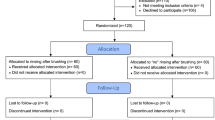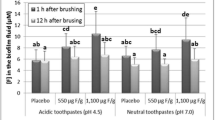Abstract
Objectives
The aim of this randomized, double-blind, crossover study was to measure fluoride in saliva and 7-day-old biofilm fluid and biofilm solids after rinsing three times per day for 3 weeks with 0, 1500, or 5000 ppm fluoride (NaF).
Materials and methods
Following the 3-week wash-in/wash-out period, including 1 week of biofilm accumulation, saliva and biofilm samples were collected from 12 participants immediately before (background fluoride), and 10, 30, and 60 min after a single rinse. Biofilm samples were separated into fluid and solids, and samples were analyzed using a fluoride electrode (microanalysis).
Results
The background fluoride concentration was statistically significantly higher in the 5000 compared to the 1500 ppm F rinse group in all three compartments (22.3 and 8.1 μM in saliva, 126.8 and 58.5 μM in biofilm fluid, and 10,940 and 4837 μmol/kg in biofilm solids). The 1-h fluoride accumulation for the 5000 ppm F rinse was higher than for the 1500 ppm F rinse in all three compartments, although not statistically significant for saliva and biofilm solids.
Conclusion
Regular exposure to 5000 ppm fluoride elevates background fluoride concentrations in saliva, biofilm fluid, and biofilm solids compared to 1500 ppm fluoride. Increasing the fluoride concentration almost 3.5 times (from 1500 to 5000 ppm) only elevates the background fluoride concentrations in saliva, biofilm fluid, and biofilm solids twofold.
Clinical relevance
Even though fluoride toothpaste may be diluted by saliva, the results of the present study indicate that use of 5000 ppm fluoride toothpaste might lead to improved caries control.



Similar content being viewed by others
References
Nordstrom A, Birkhed D (2010) Preventive effect of high-fluoride dentifrice (5,000 ppm) in caries-active adolescents: a 2-year clinical trial. Caries Res 44(3):323–331. https://doi.org/10.1159/000317490
Wierichs RJ, Meyer-Lueckel H (2015) Systematic review on noninvasive treatment of root caries lesions. J Dent Res 94(2):261–271. https://doi.org/10.1177/0022034514557330
Ekstrand KR (2016) High fluoride dentifrices for elderly and vulnerable adults: does it work and if so, then why? Caries Res 50(1 Suppl):15S–21S. https://doi.org/10.1159/000443021
Pessan JP, Conceicao JM, Grizzo LT, Szekely M, Fazakas Z, Buzalaf MA (2015) Intraoral fluoride levels after use of conventional and high-fluoride dentifrices. Clin Oral Investig 19(4):955–958. https://doi.org/10.1007/s00784-015-1426-3
Tenuta LM, Del Bel Cury AA, Bortolin MC, Vogel GL, Cury JA (2006) Ca, Pi, and F in the fluid of biofilm formed under sucrose. J Dent Res 85(9):834–838
Vogel GL, Mao Y, Chow LC, Proskin HM (2000) Fluoride in plaque fluid, plaque, and saliva measured for 2 hours after a sodium fluoride monofluorophosphate rinse. Caries Res 34(5):404–411. https://doi.org/10.1159/000016615
Williams E (1949) Experimental designs balanced for the estimation of residual effects of treatments. Aust J Sci Res 2(2):149–168
Vogel GL, Mao Y, Carey CM, Chow LC, Takagi S (1992) In vivo fluoride concentrations measured for two hours after a NaF or a novel two-solution rinse. J Dent Res 71(3):448–452
Staun Larsen L, Baelum V, Tenuta LM, Richards A, Nyvad B (2017) Fluoride in dental biofilm varies across intra-oral regions. Caries Res 51:402–409. https://doi.org/10.1159/000475510
Vogel GL, Mao Y, Carey CM, Chow LC (1997) Increased overnight fluoride concentrations in saliva, plaque, and plaque fluid after a novel two-solution rinse. J Dent Res 76(3):761–767
Vogel GL (1980) Microanalytical techniques with inverted solid state ion-selective electrodes. I. Nanoliter volumes. Anal Chem 52:375–377
Vogel GL, Carey CM, Chow LC, Ekstrand J (1990) Fluoride analysis in nanoliter- and microliter-size fluid samples. J Dent Res 69:522–528
Duckworth RM, Morgan SN (1991) Oral fluoride retention after use of fluoride dentifrices. Caries Res 25(2):123–129
Jacobson AP (1995) Low fluoride concentrations: their relevance to the inhibition of dental caries. PhD Thesis, University of Glasgow
Ekstrand KR, Ekstrand ML, Lykkeaa J, Bardow A, Twetman S (2015) Whole-saliva fluoride levels and saturation indices in 65+ elderly during use of four different toothpaste regimens. Caries Res 49(5):489–498. https://doi.org/10.1159/000434730
Richards A, Machiulskiene V, Nyvad B, Baelum V (2013) Saliva fluoride before and during 3 years of supervised use of fluoride toothpaste. Clin Oral Investig 17(9):2057–2063. https://doi.org/10.1007/s00784-013-0919-1
Ccahuana-Vasquez RA, Tabchoury CP, Tenuta LM, Del Bel Cury AA, Vale GC, Cury JA (2007) Effect of frequency of sucrose exposure on dental biofilm composition and enamel demineralization in the presence of fluoride. Caries Res 41(1):9–15. https://doi.org/10.1159/000096100
Zero DT, Raubertas RF, Pedersen AM, Fu J, Hayes AL, Featherstone JD (1992) Studies of fluoride retention by oral soft tissues after the application of home-use topical fluorides. J Dent Res 71(9):1546–1552
Naumova EA, Dickten C, Jung R, Krauss F, Rubesamen H, Schmutsch K, Sandulescu T, Zimmer S, Arnold WH (2016) Dynamics of fluoride bioavailability in the biofilms of different oral surfaces after amine fluoride and sodium fluoride application. Sci Rep 6:18729. https://doi.org/10.1038/srep18729
Rose RK, Shellis RP, Lee AR (1996) The role of cation bridging in microbial fluoride binding. Caries Res 30(6):458–464
Funding
This study was funded by the private funds “Tandlægeforeningen (FORSKU),” “Familien Hede Nielsens Fond,” and “Fonden til fremme af Odontologisk Videnskab af 2001.” The funders had no role in study design, data collection and analysis, decision to publish, or preparation of the manuscript.
Author information
Authors and Affiliations
Corresponding author
Ethics declarations
Conflict of interest
The authors declare that they have no conflict of interest.
Ethical approval
All procedures performed in studies involving human participants were in accordance with the ethical standards of the institutional and/or national research committee and with the 1964 Helsinki Declaration and its later amendments or comparable ethical standards. The study was approved by the Central Denmark Region Committees on Health Research Ethics (case no. 1-10-72-165-14).
Informed consent
Informed consent was obtained from all individual participants included in the study.
Rights and permissions
About this article
Cite this article
Staun Larsen, L., Baelum, V., Tenuta, L.M.A. et al. Fluoride in saliva and dental biofilm after 1500 and 5000 ppm fluoride exposure. Clin Oral Invest 22, 1123–1129 (2018). https://doi.org/10.1007/s00784-017-2195-y
Received:
Accepted:
Published:
Issue Date:
DOI: https://doi.org/10.1007/s00784-017-2195-y




